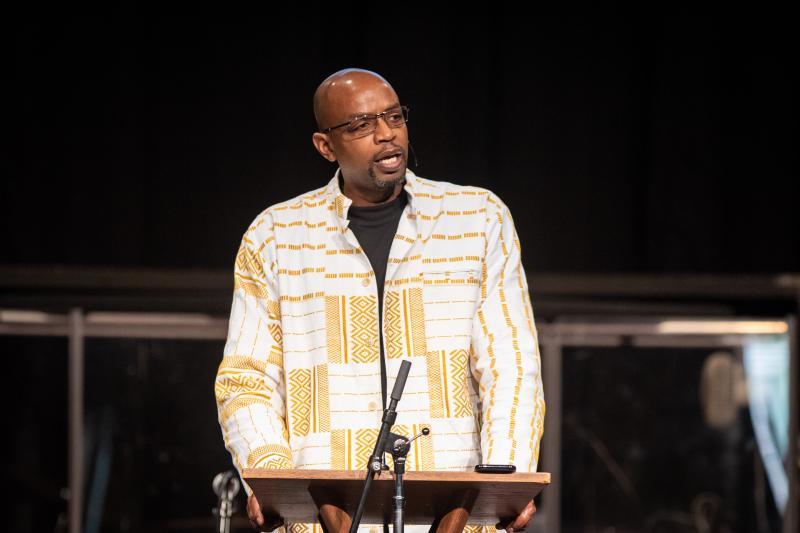Westmont Magazine Still Dreaming: Race, Ethnicity, and Liberal Arts Education
The 19th annual Gaede Institute Conversation on the Liberal Arts, February 27-29, 2020
In what ways have the liberal arts, past and present, fostered racial privilege? How can this approach to education cultivate racial justice?
The Gaede Institute’s 19th annual Conversation on the Liberal Arts focused on these questions during the last weekend of February 2020. “Still Dreaming: Race, Ethnicity, and Liberal Arts Education” welcomed participants from nearly 20 institutions across the country for a time of shared learning and conversation.
Ongoing discussions on campus about racism and the 400th anniversary of the 1619 arrival of African slaves to the American colonies prompted this year’s theme. “The conference allowed us to widen our conversation partners and to learn from outstanding scholars on the complex and often painful ways race and ethnicity intersect with higher education,” says Gaede Institute Director Christian Hoeckley. “And, of course, it meant that even as we were learning, we were contributing to nationwide discussion of vital issues.”
Estela Mara Bensimon, dean’s professor in educational equity at the University of Southern California’s Rossier School of Education and director of the Center for Urban Education, offered the opening plenary address. She posed an important question to conference attendees: Why do you perform so much better for white students than for students of color? Her talk, “Racial Equity: Higher Education’s Unpaid Debt,” highlighted the importance of equity in education and outlined strategies for implementing it through teaching practices.
A key aspect of Bensimon’s approach involves data analysis in higher education. She offers action-based, first-and second-person strategies for educators that involve them in race-conscious research into their own practices. She believes that reflecting on the racial consequences of long-accepted practices will help professors learn to change structures, practices and routines. For example, she advocates coding strategic plans to identify exclusionary language and mapping grade books with students’ race and ethnicity to create disaggregated data. Analyzing course-level data in one math class at a community college in Colorado helped the professor see the disparity in performance between white students and students of color. He made changes, such as establishing personal relationships with students and scheduling time in class so students could begin their homework there, and the success rate for Latinx students increased by 50 percent.
Equity directs resources to fix the long, broken ladder to college success that confronts students of color. Once professors become aware of the issue, they can use their power to benefit these students.
“This is a human problem and a learning problem,” she said. “Faculty can become more conscious and change their practices.”
Other plenary speakers included Rudy Busto, associate professor of religious studies at UC Santa Barbara, who spoke about “Race, Ethnicity and Alterity: Lessons from the Study of Religion.” He addressed the importance of upsetting narratives and challenging assumptions about the creation of our academic disciplines—a process he referred to as counterdisciplinarity.
With degrees in both ethnic studies and religious studies, he has discovered that issues of race and ethnicity are always present in the history of religions. He also acknowledged the contrast between the two disciplines, ethnic studies being more activist and religious studies more conservative and academic, leading to counterdisciplinarity. He believes that studying religion and race, which can be subjects of fear and misunderstanding, gives students critical tools in the classroom, fosters a hermeneutic of suspicion and frees them to ask difficult questions.
Reggie Williams ’95, a Westmont alumnus and former resident director at the college, spoke in chapel on the movement of enslaved people to the western world through prisons on the coast of Africa. He focused on the ideology of white supremacy that accompanied African bodies through this “Door of No Return” and remains present with us today.
Louis Nelson gave the closing plenary address, “Educated in Tyranny: An Institution Grappling with its Legacy of Slavery.” A professor at the University of Virginia, he has focused on the institution’s history in the wake of the 2017 “Unite the Right” rallies in Charlottesville. His talk offered an exposition on Jefferson’s designs for the institution’s buildings and how they concealed the presence of enslaved people on the campus.
“We have allowed our gaze to be distracted from alternative histories,” said Nelson, noting that stolen labor built the university and enslaved people occupied its grounds for the first 50 years. He summarized the pervasive repercussions of slavery
in Charlottesville, including a history of segregation, the removal of African American communities, and statistically lower rates of wealth and health for African Americans in comparison to the white population.
This work of truth-telling has led the University of Virginia to acknowledge its role in the history of racism and the rise of white supremacy in Charlottesville. The institution has built a memorial to enslaved people that honors their integrity and tells their true history. Descendants of enslaved people made decisions about the memorial, which features 4,000 marks, one for each person whose labor was stolen. The absence of names offers a powerful reminder of the destruction of these people.
In closing, Nelson urged attendees to “ask the hard questions of your institution. What does repair look like?... Our opportunity, especially for those of you who identify as Christians, is to enact the work of repair.”
